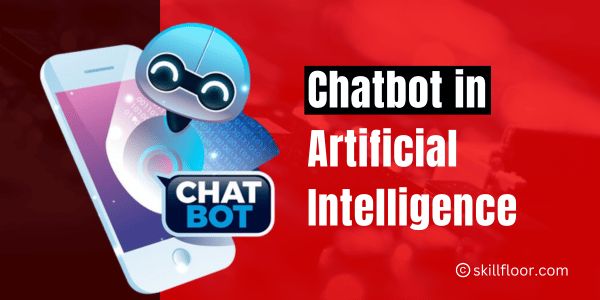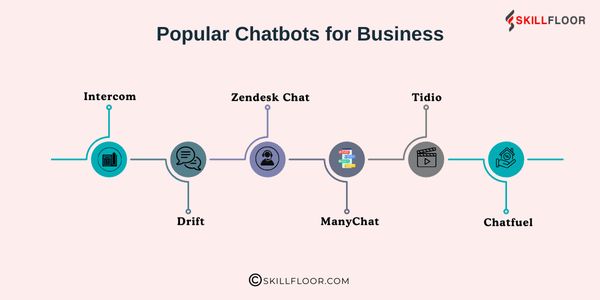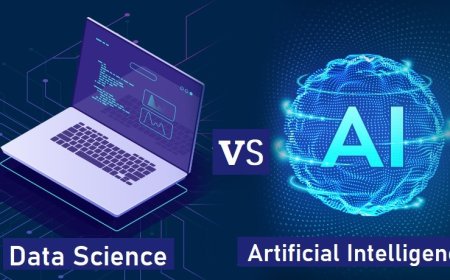What is a Chatbot in Artificial Intelligence?
Don’t miss out on the benefits of AI chatbots for your business! Enhance customer support, save costs, and boost efficiency with AI-driven automation.

As someone who's spent a lot of time exploring the world of technology, I can tell you that chatbots have become much more advanced, especially with the use of artificial intelligence (AI). While many people think of chatbots as just simple tools on websites that answer basic questions, AI chatbots are much more capable. They can understand, learn, and respond in ways that feel more like a real conversation.
So, what exactly is an AI chatbot?
Simply put, an AI chatbot is a software program that uses artificial intelligence to talk to users. It can interact through text or voice, answering questions, solving problems, and even completing tasks for you. These chatbots use technologies like Natural Language Processing (NLP) and Machine Learning (ML) to understand what you’re asking and give responses that make sense in context. The more they interact with people, the smarter they get, improving over time.
What Are the Benefits of AI Chatbots?
Over the years, AI chatbots have gained immense popularity in both consumer and business applications, and for good reason. There are several compelling benefits to implementing an AI-powered chatbot system:
1. Enhanced Customer Support
AI chatbots can handle customer inquiries 24/7 without the need for human intervention. They’re available around the clock, which is especially useful for businesses that operate in multiple time zones. The best part? They can respond instantly, reducing wait times for customers and improving the overall customer experience.
2. Cost-Effective Solution
Deploying AI chatbots significantly reduces the need for large customer service teams. While chatbots can't fully replace human agents (at least not yet), they can handle many repetitive tasks, such as answering common questions or processing basic requests, leaving human agents to focus on more complex queries. This leads to lower operational costs for businesses.
3. Improved Efficiency and Speed
AI chatbots can process hundreds, even thousands, of customer queries simultaneously. This boosts the efficiency of customer support systems, especially during high-demand periods like holidays or product launches. Moreover, AI chatbots reduce the time customers need to spend waiting for answers, making interactions faster and more efficient.
4. Personalized User Experience
Thanks to Artificial Intelligence, chatbots can learn user preferences over time. They gather data from past interactions and can make tailored recommendations, provide personalized responses, and even recognize returning customers. This not only enhances the user experience but also encourages brand loyalty.
5. Scalability
As businesses grow, the demand for customer support also increases. AI chatbots can scale effortlessly to handle more customer interactions without the need for additional staff. This scalability makes chatbots an attractive solution for growing businesses.
6. Consistent Quality of Service
Unlike human agents who might have off days, AI chatbots offer a consistent level of service at all times. They follow predefined algorithms, ensuring that customers receive uniform and accurate responses every time.
Types of AI Chatbots and Their Use Cases
AI chatbots come in various shapes and sizes, each designed to serve specific business needs. Here’s an overview of the primary types of AI chatbots and their use cases:
1. Rule-Based AI Chatbots
Rule-based chatbots are the simplest form of AI chatbots. They operate based on predefined scripts or decision trees. These chatbots recognize specific keywords or phrases and respond with a fixed set of answers. While they are limited in their ability to handle complex queries, they are still incredibly useful for automating simple tasks.
Use Case:
-
FAQ Bots: Answering commonly asked questions on websites or customer support portals.
-
E-commerce: Guiding users through the shopping process, helping them find products or track orders.
2. NLP-Powered AI Chatbots
Natural Language Processing (NLP) enables chatbots to understand and process human language, including slang, synonyms, and even different sentence structures. These chatbots go beyond simple rule-based systems and can provide more contextual responses. They are capable of understanding the meaning behind a user’s query and generating relevant replies.
Use Case:
-
Customer Support: Handling technical queries or troubleshooting issues.
-
Healthcare: Assisting patients with appointment scheduling, reminders, or even providing basic health advice.
3. Self-Learning AI Chatbots
Self-learning or machine learning-based chatbots are designed to improve over time. These bots use algorithms to analyze data from past interactions, learning from previous conversations to provide better, more accurate responses. They adapt and evolve based on user feedback, ensuring they get smarter as they are used more frequently.
Use Case:
-
Personalized Recommendations: Suggesting products based on previous interactions with a customer.
-
Customer Service: Providing more accurate solutions as the bot learns from real-time interactions.
4. Voice-activated AI Chatbots
Voice-activated chatbots leverage speech recognition technology, enabling users to interact with the bot through voice commands. These bots are used in virtual assistants like Siri, Alexa, and Google Assistant. They are ideal for hands-free interactions and can perform various tasks based on spoken commands.
Use Case:
-
Smart Homes: Controlling lights, thermostats, and other devices.
-
On-the-Go Assistance: Setting reminders, sending messages, or checking the weather while driving.
How Do Chatbots Work?
AI chatbots may seem like magic, but there’s a lot of sophisticated technology behind them. Here’s a basic breakdown of how chatbots work:
1. Understanding User Input
When a user types or speaks to a chatbot, the first step is for the bot to understand what the user is asking. This is done using Natural Language Processing (NLP), which breaks down the sentence, identifies the user’s intent, and extracts important data (like locations, dates, or names).
For example, if you ask an AI chatbot, “What’s the weather like in New York today?” the bot would use NLP to identify:
-
Intent: Get weather information.
-
Entity: Location (New York).
-
Context: Current weather.
2. Generating Responses
Once the bot understands the user’s query, it generates a response. This could be based on predefined scripts (in the case of rule-based bots) or through AI-driven models that generate contextually relevant answers. In more advanced chatbots, like NLP-based or self-learning bots, the response is generated dynamically based on patterns the bot has learned over time.
3. Machine Learning and Feedback Loops
AI chatbots often use machine learning to improve their responses. With every interaction, they collect data on what works and what doesn’t. If a user corrects the bot or provides feedback, the bot adjusts its algorithms to avoid similar mistakes in the future. This creates a feedback loop that makes the bot smarter over time.
4. Task Execution
Many chatbots are integrated with other business systems, allowing them to carry out tasks beyond just answering questions. For example, a chatbot might help you book a flight, process a payment, or update your customer profile.
Key Differences: Chatbots vs. AI Chatbots vs. Virtual Agents vs. Virtual Assistants
|
Feature |
Chatbots |
AI Chatbots |
Virtual Agents |
Virtual Assistants |
|
Technology |
Rule-based systems or simple scripts. |
Uses AI (NLP, ML) to understand and learn. |
AI-powered with multi-tasking and complex actions. |
AI-powered with voice and text-based interactions. |
|
Task Complexity |
Simple queries and predefined responses. |
Can handle more complex queries and learn. |
Handles multi-step tasks, workflows, and processes. |
Multi-tasking handles daily tasks and integrated systems. |
|
Context Awareness |
Limited, usually based on predefined scripts. |
Context-aware and adaptable. |
Can handle detailed workflows and processes. |
Highly context-aware, often integrated with the personal ecosystem. |
|
Learning Ability |
Limited or no learning capacity. |
Learned from past interactions and feedback. |
Self-improving and designed for deep tasks. |
Continuously improves based on user interactions. |
|
User Interaction |
Text-based interactions are often limited. |
Text-based, understand more complex language. |
Text and voice, handle both short and long interactions. |
Primarily voice-based, but also text-based. |
|
Use Case |
Customer support, FAQs. |
Support, recommendations, and personalized services. |
Enterprise workflows, complex support. |
Home automation, task management, smart assistance. |
Which One Should You Choose?
The choice between these technologies ultimately depends on the specific needs of your business or personal use:
-
Chatbots are ideal for small-scale interactions, especially for automating simple customer support tasks or guiding users through basic processes on a website.
-
AI Chatbots are better suited for handling more complex queries, offering personalized interactions, and improving over time with more advanced machine learning capabilities.
-
Virtual Agents are perfect for businesses or organizations that require more comprehensive automation, including task execution, multi-step processes, and integration with back-end systems.
-
Virtual Assistants offer the broadest range of capabilities, from managing personal schedules to controlling smart devices, making them the go-to choice for individuals or businesses seeking a highly integrated and multifunctional AI system.
Each technology brings a different level of complexity and capability, and understanding your needs can help you decide which one is best suited for your use case.
Popular Chatbots for Business
If you’re considering deploying an AI chatbot for your business, there are several popular platforms to choose from, depending on your specific needs. Some of the most widely used chatbots include:
1. Intercom
A robust customer messaging platform that integrates live chat, automated chatbots, and help desk features. Intercom is widely used for customer support and lead generation.
2. Drift
Focused on conversational marketing, Drift helps businesses qualify leads, schedule meetings, and increase conversions using AI chatbots.
3. Zendesk Chat
A customer service chatbot that integrates with Zendesk’s ticketing system, making it easy for businesses to handle customer inquiries.
4. ManyChat
Primarily designed for marketing, ManyChat is popular for creating chatbots for Facebook Messenger, SMS, and other social media platforms.
5. Tidio
A multi-channel customer service chatbot with live chat and AI-powered automation. Tidio is known for being an easy-to-use solution for small businesses.
6. Chatfuel
Best suited for creating Facebook Messenger bots, Chatfuel is a powerful and user-friendly platform for building automated conversations.

Which features should I look for in AI chatbots?
|
Factor |
Why it Matters |
|
Accuracy |
Ensures the chatbot provides precise and relevant answers. |
|
Automation Grade |
Determines the complexity of tasks the chatbot can handle. |
|
User-Friendliness |
Makes it easy to set up and manage the chatbot without technical expertise. |
|
Targeting Options |
Personalizes interactions based on user data (behavior, location, etc.). |
|
Integrations |
Ensures compatibility with existing tools (CRM, marketing platforms, etc.). |
|
Branding Options |
Customizes the chatbot’s appearance and tone to align with your brand. |
|
Chat Routing |
Routes inquiries to the correct department or human agent when needed. |
|
A/B Testing |
Helps optimize chatbot performance by testing different versions. |
|
Reporting & Analytics |
Provides insights into chatbot performance (engagement, accuracy, etc.). |
|
Customer Support |
Offers reliable assistance for troubleshooting or questions. |
These features will help you select the right chatbot platform for a seamless business experience.
The rise of AI chatbots has revolutionized how businesses interact with customers. With the ability to provide round-the-clock
support, automate tasks, and offer personalized experiences, AI chatbots have become indispensable tools for improving efficiency and user engagement. Whether you're looking to implement a simple rule-based bot or a sophisticated virtual assistant, the potential applications of AI chatbots are vast, making them a key part of the modern digital landscape.
By embracing AI chatbot technology, businesses can not only streamline their operations but also create a more connected, personalized experience for customers.





























































